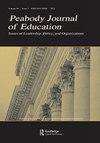Behold the Role of the District in Education Finance
Q2 Social Sciences
引用次数: 1
Abstract
The last few decades have witnessed a flurry of education finance activity centered on the role of the state, focusing on issues such as resource adequacy and equity across districts. Is the state giving districts enough money to do the job of education? Does the state funding formula or the state’s reliance on local property taxes favor some districts over others? But this Peabody Journal of Education themed issue focuses instead on the role of the district in education finance. School districts are chiefly responsible for converting tax revenues into educational expenditures at each of their schools. In that sense, this collection is about spending rather than revenues. At the risk of oversimplifying school finance, once the revenues are delivered to districts, it is then the districts that make the difficult decisions on how to spend those dollars, how much to deploy to each school, how to balance competing priorities for spending, and so on. Sure, some dollars come with strings attached, but that doesn’t negate the fact that districts then make myriad choices, from how to structure teachers’ salaries to whether to consolidate schools. Traditionally, these within-district financial policies and choices haven’t received as much attention as state education finance policy, in part because the data were much harder to come by. But the data landscape is changing rapidly. The federal Every Student Succeeds Act (ESSA) of 2015 included a landmark provision requiring states to report school-by-school per-student spending data. Some articles in this issue (Part 1) offer a first attempt at uncovering what the data mean, particularly in the context of existing financial analyses. How much money each school gets is, at least to some degree, a function of actions made at the district. In that sense, this examination of districts allows us to explore how funds are distributed to the unit of the school. With less research attention directed at district finance, scholars do not have a strong understanding of what factors drive school district resource allocation patterns across schools. School district budget models have been understudied and undertheorized. For example, why (and how) do some districts allocate resources more “progressively” than other districts? What staffing and budget models produce more equitable patterns of resource allocation? These questions are addressed in Part 2. With new school-by-school finance data, researchers are better able to connect school-by-school spending decisions to the corresponding schools’ student outcomes, and begin to understand what kinds of district policies drive a more robust relationship between spending and outcomes. School districts around the country are reforming their budget and staffing models but have limited evidence from which to base these budget decisions. Would granting additional local budgetary autonomy to school principals improve student outcomes in those schools? To what extent have weighted student funding models improved productivity or closed student achievement gaps? The papers in Part 3 do just that, applying analysis of spending alongside outcomes on a school-by-school basis. This focus on the district role in resource allocation is new. But novelty certainly is not the driver behind this issue. Better understanding of what happens to money once it reaches districts is warranted because what the district does (or does not do) has wide-reaching implications for the extent to which dollars generated at state (or federal) levels bring value to students. This spotlight on the district role in school finance isn’t temporary. If anything, it is likely to get brighter. Other看看地区在教育财政中的作用
在过去的几十年里,出现了一系列以国家作用为中心的教育融资活动,重点关注资源充足性和地区公平等问题。州政府给各地区足够的资金来做教育工作吗?州资金公式或州对地方财产税的依赖是否有利于某些地区而非其他地区?但这期以《皮博迪教育杂志》为主题的期刊却将重点放在了学区在教育财政中的作用上。学区主要负责将每个学校的税收转化为教育支出。从这个意义上说,这种收集是关于支出而不是收入。冒着过于简化学校财务的风险,一旦将收入交付给学区,学区就会做出艰难的决定,决定如何使用这些资金,向每所学校分配多少资金,如何平衡相互竞争的支出优先事项,等等。当然,有些资金是有附加条件的,但这并不能否定这样一个事实,即学区会做出无数选择,从如何安排教师工资到是否合并学校。传统上,这些地区内的财政政策和选择没有像州教育财政政策那样受到关注,部分原因是数据更难获得。但数据格局正在迅速变化。2015年的联邦《每个学生都成功法案》(ESSA)包括一项具有里程碑意义的条款,要求各州逐个学校报告每个学生的支出数据。本期(第1部分)中的一些文章首次尝试揭示数据的含义,特别是在现有财务分析的背景下。至少在某种程度上,每所学校能得到多少钱取决于学区的行动。从这个意义上说,这种对地区的审查使我们能够探索如何将资金分配给学校单位。由于对学区财政的研究关注较少,学者们对是什么因素推动了学校之间的学区资源分配模式并没有很好的理解。学区预算模型研究不足,理论不足。例如,为什么(以及如何)一些地区比其他地区更“渐进”地分配资源?什么样的人员配置和预算模式能够产生更公平的资源分配模式?这些问题将在第2部分中讨论。有了新的逐个学校的财务数据,研究人员能够更好地将逐个学校的支出决策与相应学校的学生成绩联系起来,并开始了解是什么样的地区政策推动了支出与成绩之间更牢固的关系。全国各地的学区都在改革预算和人员配置模式,但这些预算决策的依据有限。赋予校长额外的地方预算自主权会改善这些学校的学生成绩吗?加权学生资助模式在多大程度上提高了生产力或缩小了学生成绩差距?第3部分中的论文正是这样做的,在逐个学校的基础上应用支出和结果的分析。这种对地区在资源分配中的作用的关注是新的。但新奇感肯定不是这个问题背后的驱动力。有必要更好地了解资金到达学区后会发生什么,因为学区所做(或不做)的事情对州(或联邦)层面产生的资金为学生带来价值的程度有着广泛的影响。对学区在学校财政中的作用的关注并不是暂时的。如果有什么不同的话,它可能会变得更亮。另外
本文章由计算机程序翻译,如有差异,请以英文原文为准。
求助全文
约1分钟内获得全文
求助全文
来源期刊

Peabody Journal of Education
Social Sciences-Education
CiteScore
2.20
自引率
0.00%
发文量
43
期刊介绍:
Peabody Journal of Education (PJE) publishes quarterly symposia in the broad area of education, including but not limited to topics related to formal institutions serving students in early childhood, pre-school, primary, elementary, intermediate, secondary, post-secondary, and tertiary education. The scope of the journal includes special kinds of educational institutions, such as those providing vocational training or the schooling for students with disabilities. PJE also welcomes manuscript submissions that concentrate on informal education dynamics, those outside the immediate framework of institutions, and education matters that are important to nations outside the United States.
 求助内容:
求助内容: 应助结果提醒方式:
应助结果提醒方式:


